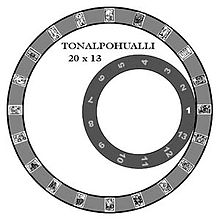The tōnalpōhualli (Nahuatl pronunciation: ), meaning “count of days” in Nahuatl, is an Aztec version of the 260-day calendar in use in pre-Columbian Mesoamerica. This calendar is neither solar nor lunar, but rather consists of 20 13-day (trecena) periods. Each trecena is ruled by a different deity.
Description

Tonalpōhualli calendar representation
The basis of the tōnalpōhualli is unknown. Several theories have been advanced for this calendrical period: that it represents a Venusian cycle, that it represents the human gestation period, or that it represents the number of days between the zenithal passage of the sun in the tropical lowlands. On the other hand, some scholars including J. E. S. Thompson suggest that the tōnalpōhualli was not based on natural phenomena at all, but rather on the integers 13 and 20, both considered important numbers in Mesoamerica.
The other major Aztec calendar, the xiuhpōhualli, is a 365-day year, based on 18 months of 20 days and five nameless days. A xiuhpōhualliwas designated by the name of its first tōnalpōhualli day. For example, Hernán Cortés met Moctezuma II on the day 8 Wind in the year 1 Reed (or November 8, 1519 in the Julian calendar).
The xiuhpōhualli and the tōnalpōhualli would coincide approximately every 52 years.
Day signs
| № | Trecena | Glyph | Aztec deities associated | Cardinal point |
|---|---|---|---|---|
| 1 | 1 Cipactli (Caiman or aquatic monster) |  |
Tōnacātēcuhtli | East |
| 2 | 1 Ehēcatl (Wind) |  |
Quetzalcoatl | North |
| 3 | 1 Calli (House) |  |
Tepēyōllōtl, Quetzalcoatl | West |
| 4 | 1 Cuetzpalin (Lizard) |  |
Huēhuecoyōtl or Macuilxōchitl | South |
| 5 | 1 Cōātl (Snake) |  |
Chalchiuhtlicue and Tlazōlteōtl | East |
| 6 | 1 Miquiztli (Death) |  |
Tōnatiuh and Tēcciztēcatl | North |
| 7 | 1 Mazātl (Deer) |  |
Tlāloc and Chicomecōātl or 4 Ehēcatl | West |
| 8 | 1 Tōchtli (Rabbit) |  |
Mayahuel and Xōchipilli or Centeōtl | South |
| 9 | 1 Ātl (Water) | Tlahuizcalpantecuhtli or Xiuhtecuhtli | East | |
| 10 | 1 Itzcuintli (Dog) |  |
Mictlāntēcutli | North |
| 11 | 1 Ozomahtli (Monkey) |  |
Patecatl and Cuāuhtliocēlōtl | West |
| 12 | 1 Malīnalli (Grass) |  |
Itztlacoliuhqui | South |
| 13 | 1 Ācatl (Reed) |  |
Tezcatlipōca or Uactli and Ixcuina or Tlazōlteōtl | East |
| 14 | 1 Ocēlōtl (Ocelot or Jaguar) |  |
Tlazōlteōtl | North |
| 15 | 1 Cuāuhtli (Eagle) |  |
Xīpe Totēuc and Quetzalcoatl | West |
| 16 | 1 Cōzcacuāuhtli (Vulture) |  |
Itzpapalotl | South |
| 17 | 1 Olīn (Movement or Earthquake) |  |
Xolotl and Tlālchitōnatiuh or 4 Olīn | East |
| 18 | 1 Tecpatl (Flint or Knife) |  |
Chalchiuhtotolin | North |
| 19 | 1 Quiyahuitl (Rain) |  |
Tōnatiuh | West |
| 20 | 1 Xōchitl (Flower) |  |
Xōchiquetzal and Tezcatlipōca | South |
Gallery of day signs
Note that the symbols are arranged counterclockwise around the calendar stone.
-

Flower, Rain, Flint, Earthquake
-

Vulture, Eagle, Jaguar
-

Reed, Grass, Monkey, Dog
-

Water, Rabbit, Deer
-

Death, Snake, Lizard
-

House, Wind, Alligator
